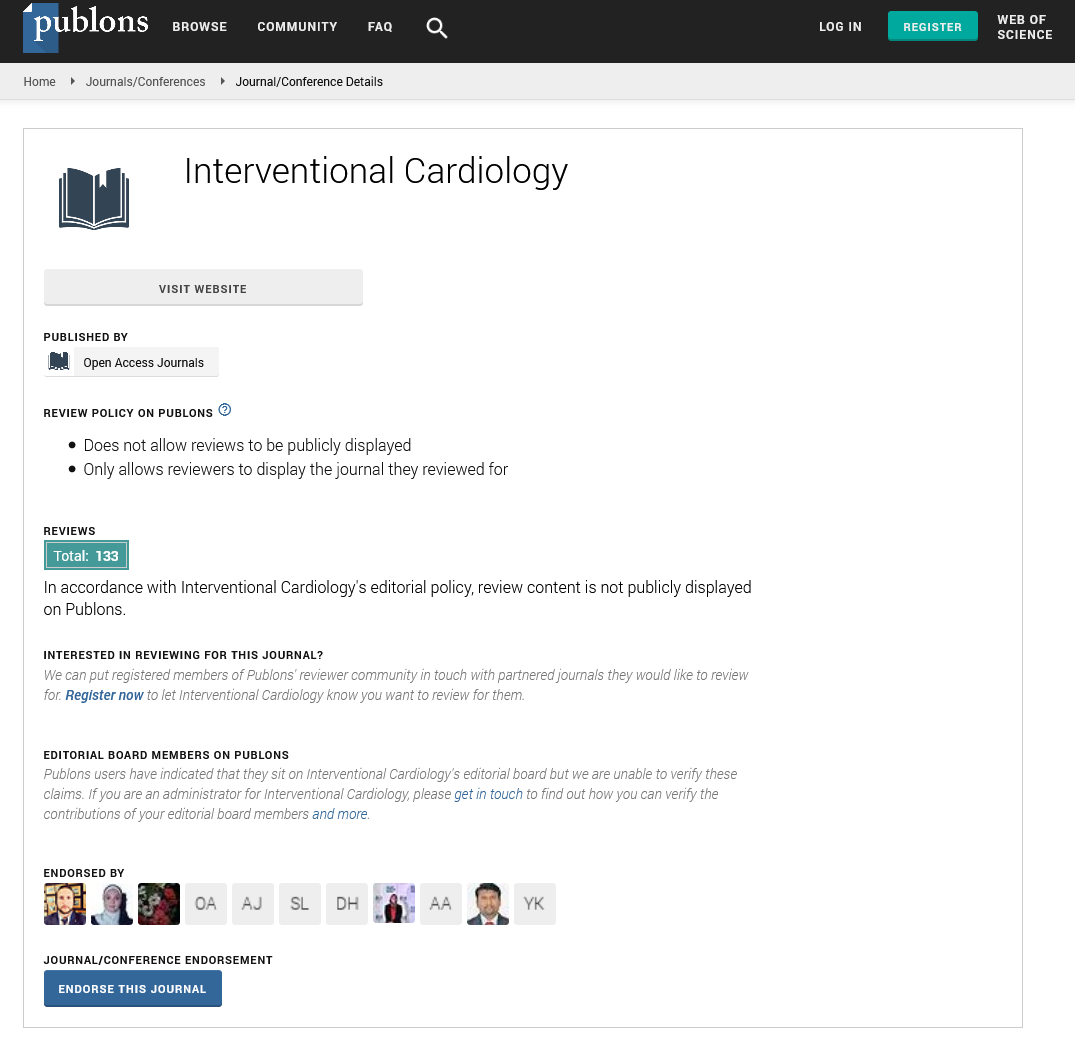Short Communication - Interventional Cardiology (2025) Volume 17, Issue 1
Role of the endovascular surgery in the management of the bullet emboli to the heart and major vessels: A summary
- Corresponding Author:
- Vsevolod Shurkhay
Ascension St. John Medical Center, Trauma and Neuroscience Institute, Tulsa, Oklahoma, United States of America
E-mail: vsevolod.shurkhay@ascension.org
Received date: 01-Jan-2025, Manuscript No. FMIC-25-161250; Editor assigned: 03-Jan-2025, PreQC No. FMIC-25-161250 (PQ); Reviewed date: 17-Jan-2025, QC No. FMIC-25-161250; Revised date: 24-Jan-2025, Manuscript No. FMIC-25-161250 (R); Published date: 31-Jan-2025, ![]()
Introduction
Bullet emboli are relatively rare complications of gunshot wounds in both the military and civilian populations. The rarity of these cases could not provide a suitable basis for clinical practice guidelines, and no universal clinical treatment algorithms are presented in the literature. This summary for the previously paper ‘Successful Surgical Management of Cardiac Bullet Emboli’ will allow us to present a short review of the endovascular management of bullet embolism. Rapid development and technical advances in the field of endovascular surgery provide an indispensable treatment tool, whose role should be presented in a more detailed fashion than in the original publication. Shannon et al. (1987) published a case of hepatic vein bullet embolism treated by percutaneous transvenous basket relocation and extraction through the femoral vein; 102 cases of venous bullet emboli since 1930 were found in the literature [1]. Another review of the bullet emboli to the systemic and venous circulation was published by Michelassi et al. (1990). The authors were able to find only 153 cases reported at the time of publication. They stated that arterial bullets were symptomatic in 80% of cases and venous in only one third. Non-symptomatic bullets must be removed because of the risk of possible spontaneous migration and further embolization [2].
Location of the emboli
Arterial embolization usually affects major arteries, such as internal carotid basilar, subclavian, brachial, aorta, iliac, femoral, and popliteal [3-11]. Venous embolism can be anterograde, retrograde, and even paradoxical; the last one is supposed to be caused by patent foramen ovale [12-17]. The most recent review of bullet embolization to the heart was published by Yoon et al. (2018). A total of 64 cases were identified throughout the literature. The majority of the patients with cardiac venous emboli were asymptomatic. A conservative approach was chosen in 45% of patients with pulmonary emboli compared to 20% with emboli to the right heart [18]. In some cases, there may be a substantial delay between the initial injury and embolic event, sometimes a few months, as it was described by Vázquez-Valdés et al. (1989) or even years [19-21].
Endovascular management of the bullet embolism
In contrast to open surgery, the endovascular approach is advocated by many authors as less invasive by nature and more suitable for asymptomatic cases.
Intracardiac emboli and emboli located in major vessels
Charniot et al. (2018) presented a case of successful percutaneous transjugular extraction of the bullet which migrated through the vena cava into the heart 2 months after injury [22]. A similar case was published by Mojtahedi et al. in 2018. The authors concluded that the small caliber bullet (<8 mm) may be removed through the sheat placed in the common femoral vein or internal jugular vein. Larger size bullets need to be pulled to the venipuncture site with further open removal. The location inside the right ventricle with the relatively larger volume of the ventricle compared to the smaller caliber of the pulmonary artery makes the snare use more difficult [23].
Minimally invasive endovascular management is recommended for hemodynamically stable patients with mandatory removal of all arterial bullet emboli, including the pulmonary venous system [24]. The benefits of the endovascular approach in the case of pulmonary artery bullet embolism were demonstrated by Ricci et al. (2024). The authors were able to relocate the bullet from the pulmonary artery back to the internal iliac vein — the site of the initial embolism [25].
Shannon and other authors demonstrated that different approaches can be used in cases of venous emboli: relocation to an accessible peripheral vein using a snare, balloon occlusion to prevent proximal migration or thrombectomy. Carter et al. (2012) in their article, emphasize that the venous bullet emboli should be removed using an endovascular technique whenever it is technically possible [26]. If the bullet fragments are embolized to the major cerebral arteries, no unified approach exists. In the majority of cases involving cerebral vasculature, anterior circulation emboli dominate, and the posterior circulation is far less affected.
Some authors, for example, Clouse et al. (2023), demonstrated that in cases of embolism to the middle cerebral artery, the major stroke can be ameliorated by mechanical thrombectomy distal to the bullet, especially when it is firmly lodged within the vessel [27].
In their publication, Mingo et al. (2020) presented a case of near- complete clinical recovery after an ischemic stroke caused by bullet embolization to the distal M1 branch of the left middle cerebral artery. Despite the development of aphasia and hemiplegia, the bullet was left intact because of the location [28].
Bullet emboli in the posterior circulation may require a planned sacrifice of the vertebral artery to prevent re-embolization. A successful example of this approach was presented by Ahmed et al. (2022). Using the transarterial route, they were able to relocate the bullet from the apex of the basilar artery to the vertebral artery with subsequent occlusion of the vertebral artery.
Hassan et al. (2019) demonstrated that the bullet can safely be removed from the tip of the basilar artery using a direct aspiration first pass technique; thus no sacrifice of the vertebral artery is needed. It should be noted that the bullet size in this case was small enough (2.5 mm) to hold on the tip of the catheter.
Conclusion
The endovascular approach for the management of bullet embolism in general is a safe and effective method. Nonetheless, no consensus exists in the literature about when and where it should be used. Many authors advocate the endovascular approach as a change to first-line treatment, though it can be limited by the experience, lack of resources, or location of the emboli. The generalized conclusion is that it can be used as a viable alternative to open surgery or be an important part of the hybrid approach. Cerebral embolism is even more uncommon and requires a detailed examination of the vascular anatomy before attempting to remove the bullet. In the meantime, the expanding armamentarium of the endovascular tools available to the surgeon permits successful removal of the emboli from such difficult locations as a posterior circulation. In the selected cases, the bullet, located in the anterior circulation, can be left intact, which does not prevent the clinical recovery of the patient.
References
- Shannon FL, Mccroskey BL, Moore FA, et al. Venous bullet embolism: Rationale for mandatory extraction. J Trauma. 27(10):1118-1122 (1987).
[Google Scholar] [PubMed]
- Michelassi F, Pietrabissa A, Ferrari M, et al. Bullet emboli to the systemic and venous circulation. Surgery. 77(4):466-472 (1990).
[Google Scholar] [PubMed]
- Clouse J, Thaci B, Clark AS, et al. Successful mechanical thrombectomy for terminal ICA bullet embolism: A case report. Interv Neuroradiol. 10:15910199231219021 (2023).
[CrossRef] [Google Scholar] [PubMed]
- Duerr S, Cocco T. Gunshot wound of the abdomen with cerebral embolization. J Trauma. 17(2):155-157 (1977).
[CrossRef] [Google Scholar] [PubMed]
- Ahmed SU, Kelly ME, Peeling L, et al. Endovascular retrieval of bullet fragment from the basilar artery terminus. J Neurointerv Surg. 14(10):1042-1044 (2022).
[CrossRef] [Google Scholar] [PubMed]
- Green P, Clark J, Gupta S, et al. Subclavian artery bullet embolism. J Trauma Acute Care Surg. 90(3):e65-e66 (2021).
[CrossRef] [Google Scholar] [PubMed]
- Belghith M, Lejeune J, Blum A, et al. Unusual bullet embolism in the brachial artery: Case report and literature review. Leg Med (Tokyo). 55:102024 (2022).
[CrossRef] [Google Scholar] [PubMed]
- Tran D, Jones D, Moore R, et al. Abdominal aorta bullet embolism: Presentation and management. Ann Vasc Surg. 74:524-e17 (2021).
[CrossRef] [Google Scholar] [PubMed]
- Lovasik BP, Nauser CL, Klingensmith NJ, et al. Bullet Embolism into the common iliac artery from a gunshot wound to the heart. Am Surg. 88(5):1014-1015 (2022).
[CrossRef] [Google Scholar] [PubMed]
- Landim RM, Soares Filho AW, Cardoso DL, et al. Femoral artery embolism of bullet after thoracic gunshot wound. J Vasc Surg Cases Innov Tech. 3(3):186 (2017).
[CrossRef] [Google Scholar] [PubMed]
- AlAttab N, Wani T, Alomar K, et al. Bullet embolism: A rare cause of acute ischaemia. Interact Cardiovasc Thorac Surg. 34(6):1186-1187 (2022).
[CrossRef] [Google Scholar] [PubMed]
- Yu H, Hillman CL, Globerman A, et al. Anterograde venous bullet embolism from the left facial vein to the right ventricle. Trauma Case Rep. 36:100552 (2021).
[CrossRef] [Google Scholar] [PubMed]
- Bors V, Aubert S, Flecher E, et al. Bullet embolization from the left brachiocephalic vein to the right ventricle. J Card Surg. 23(2):176-177 (2008).
[CrossRef] [Google Scholar] [PubMed]
- Sclafani SJ, Mitchell WG. Retrograde venous bullet embolism. J Trauma. 21(8):656-657 (1981).
[CrossRef] [Google Scholar] [PubMed]
- Hosseinzadeh A, Moeini Farsani M, Mahmoudi MM, et al. Simultaneous retrograde venous and anterograde arterial bullet embolism: A case report. J Med Case Rep. 16(1):198 (2022).
[CrossRef] [Google Scholar] [PubMed]
- Jafroodifar A, Thibodeau R, Goel A, et al. Wandering intravascular air gun BB pellet. Radiol Case Rep. 15(12):2627-2631 (2020).
[CrossRef] [Google Scholar] [PubMed]
- Schurr M, McCord S, Croce M, et al. Paradoxical bullet embolism: Case report and literature review. J Trauma. 40(6):1034-1036 (1996).
[CrossRef] [Google Scholar] [PubMed]
- Yoon B, Grasso S, Hofmann LJ, et al. Management of bullet emboli to the heart and great vessels. Mil Med. 183(9-10):e307-e313 (2018).
[CrossRef] [Google Scholar] [PubMed]
- Vázquez-Valdés E, Centeno-Olguín V, Hernández-Zamora JM, et al. Embolism caused by a bullet. Rev Invest Clin. 41(1):57-62 (1989).
[Google Scholar] [PubMed]
- Wales L, Jenkins DP, Smith PL, et al. Delayed presentation of right ventricular bullet embolus. Ann Thorac Surg. 72(2):619-620 (2001).
[CrossRef] [Google Scholar] [PubMed]
- Levi B, Sainsbury CR, Scharf DL, et al. Delayed shotgun pellet migration to the right ventricle. Clin Cardiol. 8(6):367-371 (1985).
[CrossRef] [Google Scholar] [PubMed]
- Charniot JC, Cluzel P, Leprince P, et al. Percutaneous transjugular extraction of venous bullet embolism to the right ventricle. Ann Thorac Surg. 106(6):e281-e283 (2018).
[CrossRef] [Google Scholar] [PubMed]
- Mojtahedi A, Contractor S, Kisza PS, et al. Endovascular approach for management of bullet embolization to the heart. Vasc Endovascular Surg. 52(4):295-298 (2018).
[CrossRef] [Google Scholar] [PubMed]
- Castater C, Noorbakhsh S, Harousseau W, et al. Missing bullets: Bullet embolization case series and review of the literature. Vasc Endovascular Surg. 57(3):281-284 (2023).
[CrossRef] [Google Scholar] [PubMed]
- Ricci C, Hughes J, Miles G, et al. Endovascular removal of pulmonary artery bullet embolus: Case report and literature review. Vasc Endovascular Surg. 58(7):789-797 (2024).
[CrossRef] [Google Scholar] [PubMed]
- Carter CO, Havens JM, Robinson WP, et al. Venous bullet embolism and subsequent endovascular retrieval-A case report and review of the literature. Int J Surg Case Rep. 3(12):581-583 (2012).
[CrossRef] [Google Scholar] [PubMed]
- Mingo M, Cao D, Ezepue C, et al. Embolic shotgun pellet to the left middle cerebral artery causing hemiplegia and aphasia with near complete clinical recovery on nonoperative management. Cureus. 12(11) (2020).
[CrossRef] [Google Scholar] [PubMed]
- Hassan AE, Rabah RR, Tekle W, et al. Intracranial pellet embolization: An endovascular endeavor. BMJ Case Rep. 12(12):e015301 (2019).
[CrossRef] [Google Scholar] [PubMed]

